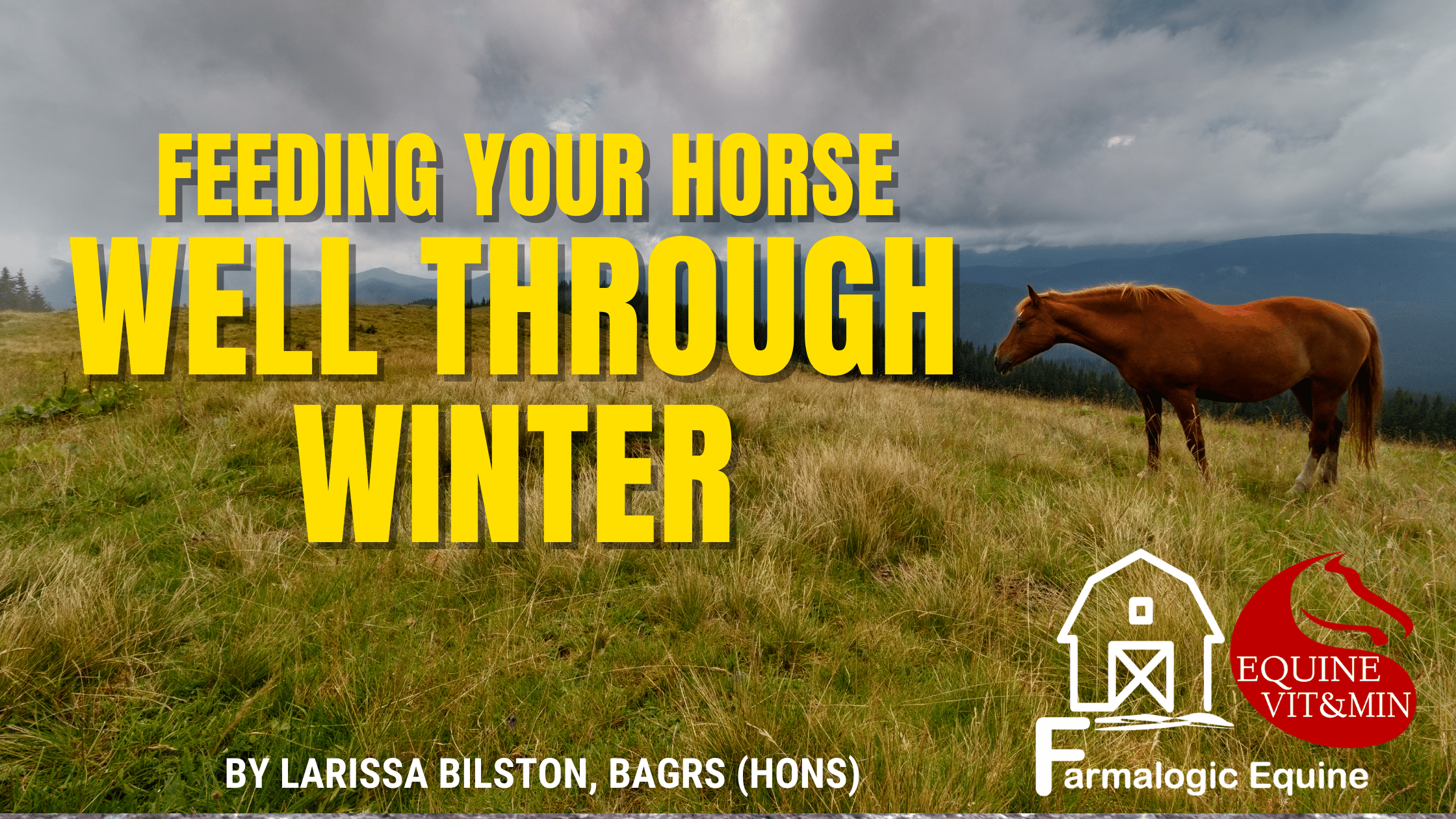Most horse diets need tweaking through winter to compensate for seasonal reduction in pasture quantity and quality whilst horses burn extra calories to keep warm.
Older horses in particular can have trouble maintaining weight through cold weather as their bodies become less efficient at producing, processing and absorbing nutrients.
Minimise issues with winter weight loss by taking care of teeth, worming or other veterinary issues early and before the full stress of winter hits.
Keep them warm
The two most important things you can do for your horses through winter are also the two easiest – keep them warm and feed plenty of hay.
The body uses energy (calories) to stay warm during cold weather and for horses with a lower body condition score it is energy they cannot afford to lose. Providing rugs, wind breaks or shelters will help older and underweight horses use more of their available energy for weight gain and maintenance.
Provide adequate roughage
Plant growth is naturally slower in winter due to longer nights and less sunlight hours for photosynthesis to occur. Plants also become stressed due to cold weather, frosts, drought and water-logged conditions which further restricts their growth.
As a result there is less pasture available for horses to graze and supplementation with grass or meadow hay is usually necessary.
Horses need to be able to eat approximately two per cent of their bodyweight in dry matter per day to keep their gut functioning optimally. That equates to at least 10 kg of hay or up to 18 kg of grass per day for a 500 kg horse. Read more here about how much to feed your horse.
The horse gut evolved to constantly digest a steady stream of fairly low energy, high fibre forage. When pasture is in limited supply, it is essential to provide enough good quality grass or meadow hay to fill the gap in pasture availability. Hard-keepers and underweight horses will benefit from access to free choice hay whenever pasture is overgrazed or the average length of leaves in the pasture falls below ankle height.
For overweight horses and those with metabolic conditions who are prone to laminitis it is necessary to limit access to short, green or stressed grass as these are higher in the sugars and carbohydrates that can cause weight gain and trigger laminitis.
Although spring and autumn are the highest risk times for laminitis, it is important to monitor pasture and horses carefully through winter as well. When weight loss is necessary, remove horses from pasture and supply low calorie (or soaked) hay at a rate of 1.5 per cent of their bodyweight per day.
Slow feeder hay nets can help make the daily ration last longer to avoid the stress and gastric ulcer risk associated with leaving horses for hours without roughage.
A bonus for horses eating plenty of hay or grass during cold weather is that fibre digestion occurs through fermentation by hindgut microbes which produces heat and has a ‘warming’ effect.
Adequate roughage usually provides enough protein to meet the daily needs of adult horses but some older horses are less efficient at digesting protein and may need extra protein in their diet. Higher protein feeds include lucerne, clover, soy or legume products.
Add calories
Some horses will get enough energy (calories) from hay and grass to maintain weight through the winter but many will need a hard feed to maintain weight. Be prepared to increase the size of hard feeds in response to weight loss but always ensure adequate roughage (as pasture or hay) is available before deciding to introduce or increase hard feeds.
If you’re looking for something to top up a diet to put weight on you don’t necessarily need a product that says ‘weight gain’ on the bag – you only need to add more calories. This is often easiest achieved by feeding more of what you already feed.
You can increase the level of energy (calories) in the diet with a cereal grain (such as oats or barley), a legume grain (like soy or lupins), a ‘super fibre’ (such as copra, beet pulp or soy hulls) or oil. You can use these ingredients alone or combination or as part of a premixed pellet or muesli blend.
When choosing your grain or energy source, consider how much time and energy you are willing to put into preparation. Whole oats can be fed raw, but other cereal grains such as barley or corn should be fed in a cooked form. You can boil them or buy steam-flaked, pelleted, extruded or micronized grains. Super fibres usually require a short period of soaking to absorb water while whole lupins are best soaked for hours to soften the seed coat. Click here for more information on feeding for weight gain.
If you are feeding older horses, take into account the condition of your horse’s teeth and digestive efficiency when choosing a hard feed.
The amount of hard food required depends on the horse’s size, level of activity or breeding status, the amount of energy provided by the pasture or hay and the individual’s metabolism (easy-keeper or hard keeper).
Research shows that some older horses experience a decline in the function and efficiency of their digestive tract but others seem to process feed as robustly as ever. Horses produce less saliva as they age so dampening feeds assists the process of chewing and swallowing.
Balance the vitamins, minerals and fatty acids
Feeding a correctly formulated diet complete with all the vitamins, minerals and fatty acids in balance allows the horse’s body to function optimally. This can result in improved ‘fuel efficiency’ and immune function to help horses through the stress of winter.
Horses will always be deficient in some minerals and vitamin E, regardless of pasture quality, unless supplemented. Even the best pasture in the world, able to provide more than enough calories and protein to keep horses fat and shiny, fails to provide enough of the microminerals copper or zinc and often selenium and iodine. The macrominerals calcium, phosphorous, salt and magnesium are also frequently needed to balance mineral ratios across the whole diet.
Vitamins and minerals can be supplemented by providing the full recommended amount of a quality pre-mixed feed, or by adding a balancer powder or pellet. If feeding a reduced rate of pre-mixed pellets or muesli, use a balancer powder to top up and balance your horse’s vitamin and mineral requirements.Remember that it is possible for a horse to be deficient in one mineral even if the recommended daily intake is given unless all minerals are provided in correct mineral ratios. Click here if you’d like free expert advice on balancing your horse’s diet.
Omega-3 fatty acid supplementation can be necessary through winter when horses are reliant on hay for roughage and are fed more omega-6 rich grains, oils and hard feeds. Omega 3 rich supplements such as Farmalogic Omega Balancer containing a combination of ALA, EPA and DHA are the best way to improve the omega 3 to 6 ratio across the whole diet. Omega-3 supplements can also assist horses with inflammatory conditions such as arthritis, airway disease, allergies and itchy skin.
Tips for Choosing Hay for Winter
Grass or meadow hay is the best choice to substitute for pasture when grass growth is poor due to seasonality or over-grazing. Lucerne hay is a good way to boost protein intake but should be limited to no more than thirty per cent of the roughage intake.
When buying, choose hay that smells sweet and fresh. Look for lots of leaf in the hay – stalky hay, and significant amounts of seed heads are signs of poorer quality hay made from mature plants.
Avoid hay that is:
- too stalky
- dark in colour
- dusty
- browning (especially on the bottom of bales)
- hot to touch
- smells of mould
- displays visible fungus.
When stacking hay in your shed, arrange it so that the oldest hay can be used first.

Save 5% on Farmalogic Equine supplements when you buy a winter health bundle! Only from Farmalogic Online!



